Tonner Gone With The Wind Dress “Lost Outfit” Trip To Saratoga NRFB. The item “Tonner Gone With The Wind Dress Lost Outfit Trip To Saratoga NRFB” is in sale since Thursday, October 14, 2021. This item is in the category …
Continue reading
Tag Archives: uchikake
Silk Wedding Kimono Outfit with Uchikake for 15-16 Dolls Gene Tyler Tonner a2
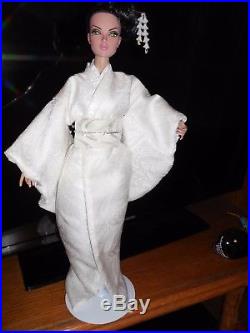
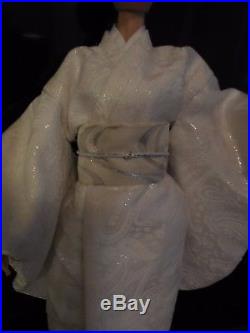
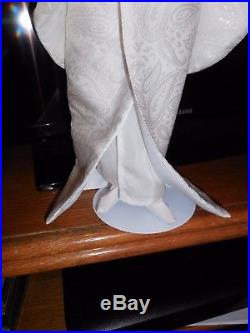
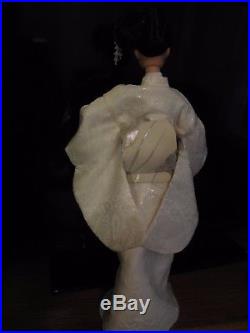
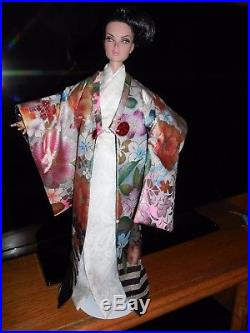
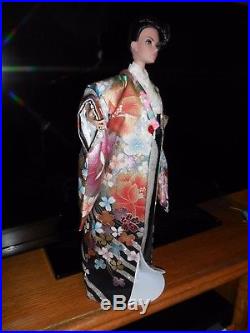
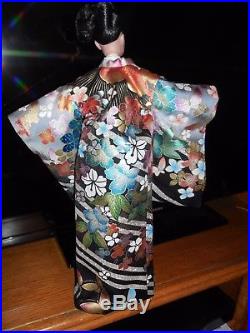
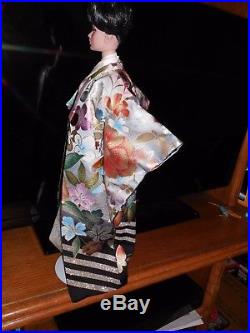
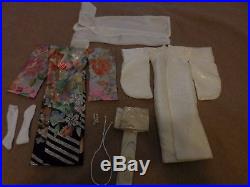
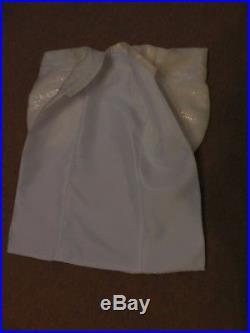

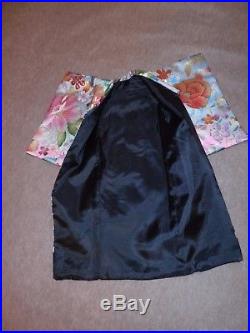

A Brief Kimono History. Whoever invented the Japanese kimono design has been lost to time. The word kimono simply means, thing to wear. That was the only word needed in the beginning for a type of clothing worn by everyone. The only differentiation was a mans kimono or a womans kimono. The mens kimono was and still is a dark-colored hip-length jacket with short sleeves, with more somber embellishments (with a front-pleated skirt worn beneath the kimono); while the womens kimono is floor-length, with longer sleeves, and often with colorful designs on the fabric. Most womens kimono are the same length, and are tucked up under the obi, as necessary, to prevent it from trailing on the ground. The under-kimono is almost always white, usually cotton, and is worn to protect the kimono from getting stained by the body. Kimono are always worn showing the collar(s) of the under-kimono. Sometimes, two or more under-kimono are worn with only the innermost one being white, but more often in modern times, a woman might cheat by wearing one or more colorful collars under her kimono instead of wearing all the extra fabric. The collars are worn low in the back, as Japanese men like to see the back of a womans neck, which they think is sexy. The obi is the very wide belt worn to hold the kimono together. From my observation, it seems that the plainer the kimono, the more colorful the obi, and vice versa. The obi is made from a heavier fabric than the kimono. It should be of such a color and pattern that it complements the kimono. An obijime is a cord that is tied over the obi. It usually has a knot or some sort of beaded design in the middle. The obijime is tied, usually in a bow, and then is moved around so that the knot is centered in the front, with the bow hidden under the obi tie in the back. Kimono range from extremely formal to casual. Nowadays, there are many different Japanese words to describe kimono of different styles, depending on the length of the sleeves, the type of design, the location of the design on the fabric, whether the only design is in the jacquard or brocade weave, or other factors. The wedding kimono is white, often with a rich jacquard weave in the design of the fabric. The obi is worn over the wedding kimono. Over all is a type of kimono coat, called uchikake, which is often very elaborately brocaded and/or embroidered, and which is left open to show the wedding kimono underneath. The obi never goes over the uchikake. The uchikake may have a white base, usually with all-white brocade or embroidery, or it may have a colorful base, often red, with very colorful and richly designed brocade and/or embroidery, or other type of design, such as lamé or even metallic stamping. The Artistry of the Kimono. The Japanese are extremely talented artists, never more so than when designing kimono fabric. Many of the fabrics are decorated with what Westerners call a jacquard weave. Often, this design is the sole decoration on the fabric. Other times, a print may be made over the jacquard, usually in a completely different pattern. Or a design may be printed over plain fabric. Print patterns vary from extremely realistic, to impressionistic, to geometric, to very abstract, and everything in between. They may show country scenes, village life, various flowers or leaves, animals and/or birds virtually almost anything. You will see a myriad of flowers, but the most-favored one is the chrysanthemum. Likewise, you may see several different kinds of birds peacock, partridge, duck, even a firebird but more often than not, you will see cranes, usually in flight. This shimmering beauty is a delicate silk with a paisley jacquard and is infused with shiny threads that really show off the pattern. It is lined with a heavy white silk to give it body and weight. Under-kimono is made of China silk. Obi is constructed of heavy white and silver fabric and is the traditional obi presentation. Obijime is also silver and white. Socks are of cotton and elastic. The magnificent uchikake is a black silk base fading to gray to pink and has metallic stamped flowers and butterflies covering the fabric. Included is a free hair ornament of white Czeck pressed-glass flowers dangling from a silver hair pin. I know you will love this outfit as much as I do! This offering includes the outfit only, not the doll. Track Page Views With. Auctiva’s FREE Counter. The item “Silk Wedding Kimono Outfit with Uchikake for 15-16 Dolls Gene Tyler Tonner a2″ is in sale since Tuesday, October 17, 2017. This item is in the category “Collectibles\Cultures & Ethnicities\Asian\1900-Now\Japanese\Kimonos”. The seller is “pretty_things_online” and is located in Clermont, Florida. This item can be shipped to United States, Canada, United Kingdom, Denmark, Romania, Slovakia, Bulgaria, Czech republic, Finland, Hungary, Latvia, Lithuania, Malta, Estonia, Australia, Greece, Portugal, Cyprus, Slovenia, Japan, China, Sweden, South Korea, Indonesia, Taiwan, South africa, Thailand, Belgium, France, Hong Kong, Ireland, Netherlands, Poland, Spain, Italy, Germany, Austria, Russian federation, Israel, Mexico, New Zealand, Philippines, Singapore, Norway, Saudi arabia, Ukraine, United arab emirates, Qatar, Kuwait, Bahrain, Croatia, Malaysia, Brazil, Chile, Colombia, Costa rica, Dominican republic, Panama, Trinidad and tobago, Guatemala, El salvador, Honduras, Jamaica, Antigua and barbuda, Aruba, Belize, Dominica, Grenada, Saint kitts and nevis, Saint lucia, Montserrat, Turks and caicos islands, Barbados, Bangladesh, Bermuda, Brunei darussalam, Bolivia, Ecuador, Egypt, French guiana, Guernsey, Gibraltar, Guadeloupe, Iceland, Jersey, Jordan, Cambodia, Cayman islands, Liechtenstein, Sri lanka, Luxembourg, Monaco, Macao, Martinique, Maldives, Nicaragua, Oman, Peru, Pakistan, Paraguay, Reunion.


